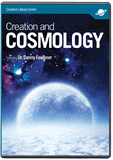
Astronomical Objects Formed "Recently"
Two stories this week report on astronomical objects—moons and a planet—that may have formed relatively “recently,” at least in terms of billions-of-years belief.
News Source
- Science: “Is Our Solar System Still Making Moons?”
ScienceNOW covers simulations that show that some of Saturn’s moons may have formed as “recently” as 10 million years ago. That may sound like long ago, but it pales in comparison to the alleged “4 billion years old” age of Saturn’s other moons. Based on the simulation, study coauthor Sébastien Charnoz, a planetary scientist at Paris Diderot University, explained, “We see that it is possible, even today, to form new [moons].”
This makes Beta Pictoris b the youngest star known to host a planet.
In related news reported by the BBC, astronomers have discovered an exoplanet orbiting the extremely young (again, relatively) star Beta Pictoris b. (An exoplanet is a planet orbiting a star other than our own sun.) This makes Beta Pictoris b the youngest star known to host a planet—the star is “only” 12 million years old, less than half a percent of the sun’s supposed age. “The presence of an exoplanet around Beta [Pictoris b] proves that [gas giants] of about nine Jupiter masses form on a time scale of 10 to 12 million years—very early in the formation of the stars themselves,” noted the European Southern Observatory’s Markus Kasper.
If planetary and lunar formation can occur far faster than astronomers previously believed in the past, could it be that planets and moons can actually form more rapidly than astronomers believe today? Given the short time period during which humans have actively been able to study the universe, we can only collect “snapshots” of what’s going on in the universe. The conclusion that such objects take millions or billions of years to form is not an observation, but instead an interpretation based on a uniformitarian view of the universe. In the same way, a belief that planets, moons, and other stellar objects could have formed either thousands of years ago at creation or in the thousands of years since is an interpretation based on a biblical view of the universe.
Another news story this week helps emphasize our point. Time magazine covers a new study that argues that many of the sun’s comets didn’t form in our solar system at all, instead having come from elsewhere in the galaxy. The conclusion stems from the fact that the Oort cloud seems “too big to have all been birthed by our proto-sun.”
The idea of the Oort cloud goes something like this: if our solar system’s comets are routinely destroyed (through melting/decay, collisions, etc.), the solar system should have run out of comets millions of years ago. Therefore there must be far more than we think, lurking unseen far beyond Pluto’s orbit, in a large cloud. Occasionally, an interstellar object causes a comet’s orbit to destabilize and it travels toward the sun, often for a final voyage.
But Southwest Research Institute astronomer Hal Levison points out that the hypothesized size of the Oort cloud is “a couple of orders of magnitude” too big to have come from the same matter that (supposedly) formed the sun and the planets of the solar system. Levison and others have created a computer model that places the origins of the Oort cloud comets in the days when the sun was part of a larger interstellar body of matter. In the end, Time reports, “just about every Oort Cloud comet that visits the inner solar system, including Halleys’ . . . , formed around a star other than the Sun,” and we are “likely to have seen only one locally born comet in the history of human observation.”
The conclusion may be sound based on the same presuppositions that gave rise to the Oort cloud: namely, that the sun’s comets should all be gone after billions of years, and thus that we must explain why comets are still around. But given that the Oort cloud can’t be seen, old-agers must have faith in such an object to sustain their uniformitarian perspective, whereas comets pose no problem for the young-age, biblical view.
Further Reading
- The Heavens Declare . . . A Young Solar System
- Comets and the Age of the Solar System
- More Problems for the ‘Oort Comet Cloud’
- Does the Bible Say Anything about Astronomy?
- Get Answers: Astronomy, Age of the Earth
For More Information: Get Answers
Remember, if you see a news story that might merit some attention, let us know about it! (Note: if the story originates from the Associated Press, FOX News, MSNBC, the New York Times, or another major national media outlet, we will most likely have already heard about it.) And thanks to all of our readers who have submitted great news tips to us. If you didn’t catch all the latest News to Know, why not take a look to see what you’ve missed?
(Please note that links will take you directly to the source. Answers in Genesis is not responsible for content on the websites to which we refer. For more information, please see our Privacy Policy.)
Recommended Resources

Answers in Genesis is an apologetics ministry, dedicated to helping Christians defend their faith and proclaim the good news of Jesus Christ.
- Customer Service 800.778.3390
- © 2024 Answers in Genesis






